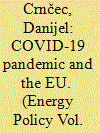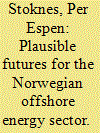|
|
|
Sort Order |
|
|
|
Items / Page
|
|
|
|
|
|
|
| Srl | Item |
| 1 |
ID:
191271


|
|
|
|
|
| Summary/Abstract |
The article examines the implications held by the EU's response to the COVID-19 pandemic for the green transition as set by the European Green Deal. It distinguishes changes in: (a) the use of policy instruments; (b) governance principles; and (c) the prioritising of policy goals as expressed via the conceptual framework of orders of change. The article assesses the extent of these changes as well as the patterns and regional variations among EU Member States, together with the Commission's role in pushing for preferential energy policy choices and encouraging the Member States' ambitions. The analysis shows the EU Energy Union governance framework was promoting the EU's climate targets' full integration into the EU's energy transition policy instruments (first order of change) even before the European Green Deal. Still, the EU's response to the COVID-19 crisis created strong financial and policy leverage to accelerate the green transition and gave an opportunity to close the gap between less ambitious and more ambitious EU countries. Many countries traditionally reliant on EU funds seized this opportunity, demonstrating the role of changed governance principles (the second order of change). However, the crisis has had an evolutionary impact, not a revolutionary one. While coherence between the energy and climate goals remains high, the EU's energy transition is falling short in fully integrating biodiversity (which would constitute a full paradigmatic, third-order change), despite this being an essential component of the EU's green transition.
|
|
|
|
|
|
|
|
|
|
|
|
|
|
|
|
| 2 |
ID:
170835


|
|
|
|
|
| Summary/Abstract |
Combating climate change at a global scale requires dramatic
mobilization of capital markets. By 2035, more than $53 trillion will need to
be invested in energy supply and efficiency in order to achieve climate targets
laid out in the 2015 Paris Agreement. Interest and participation in sustainable
finance continues to grow: environmental, social, and governance (ESG)
investing assets under management totaled $30.7 trillion (of which $1 trillion is
specifically classified as sustainability-themed) at the start of 2018, representing
a 34% increase over the preceding two years. Yet, the capital that is available
for investment in sustainable assets may not be well-matched with the pipeline
of projects in search of financing. Green asset classes, including renewable
generation, infrastructure, energy efficiency, and clean transport, are often
inherently novel, small, and/or disaggregated. This makes them difficult and
expensive to combine into investment-ready formats, preventing capital from
being deployed on the timescale required to enable a quick energy transition.
Moreover, market barriers exist with respect to early-stage financing and proving
the viability of new markets and business models. In this article, we explore
the hurdles and barriers that financial actors must overcome to ensure efficient
capital matching that bridges the gap between climate awareness and meaningful
climate investment
|
|
|
|
|
|
|
|
|
|
|
|
|
|
|
|
| 3 |
ID:
162976


|
|
|
|
|
| Summary/Abstract |
The aim of this article is to examine the shifting strategies towards the dependence on imported energy which has originated from the lack of energy resources in Denmark. The article suggests that the international economic conditions strongly influenced the energy strategies chosen in the 1950s and 1960s. In the 1970s and onwards, the dependence was dealt with as a combination of diversification of the energy mix, conservation and improved efficiency.
|
|
|
|
|
|
|
|
|
|
|
|
|
|
|
|
| 4 |
ID:
115104


|
|
|
|
|
| Publication |
2012.
|
| Summary/Abstract |
Europe has played the role of a green hegemon on the global arena for several decades. By exploring its green transition in the electricity industry, the article discusses whether Europe is on track with regard to delivering sustainable development in a core sector at home.
The article finds that the greening of European electricity industry has been highly dynamic and can best be represented in terms of competing modernities; where carbon, nuclear, renewables and demand side management challenge each other in the race for sustainable energy solutions.
The article describes Greening European electricity industry as a complex institutional game which resembles a relay race where various factors have driven innovation at different stages. Change may be initially have been politically driven, while the baton is later taken by markets, technology or civic mobilization. The article shows how strong greening policies may lead to blockage, whereas softer and less confrontational policies with triggering effects may have a better chance of success.
The article also argues that a central factor in the apparent European success in greening electricity has been an advantageous blend of technology push and market pull approaches, which has merged out of national rivalry rather than coordinated planning.
|
|
|
|
|
|
|
|
|
|
|
|
|
|
|
|
| 5 |
ID:
192726


|
|
|
|
|
| Summary/Abstract |
The global energy transition from fossil to low-carbon energy challenges the future of the Norwegian petroleum sector, a major factor in the country's economy, now facing financial climate risk and long-term declining demand, particularly for gas to the EU. What energy policies can assist transition into a low-carbon society? We explore three investment scenarios for the Norwegian offshore energy sector from 2020 to 2070: 1) Business as usual, 2) Increasing cash-flow by harvesting existing petroleum fields and cutting investments (Harvest-and-Exit), or 3) Rebuilding with green offshore energy investments. In a new economic model, we compare impacts on key macro- and sector-economic variables. We find that rebuilding by investing moderately in green offshore energy production could reverse the extra job decline that a quicker phase-out of petroleum investments would incur. The impacts on the Norwegian sovereign wealth fund - Government Pension Fund Global - and on gross domestic product (GDP) per capita are insignificant to 2050 and positive by 2070. The simulated investments and economic results can be compared with observations to constitute forward-looking indicators for energy transitioning in producer countries.
|
|
|
|
|
|
|
|
|
|
|
|
|
|
|
|
|
|
|
|
|